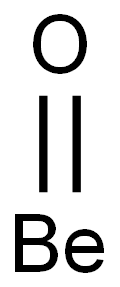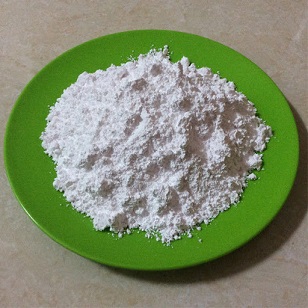BERYLLIUM OXIDE

- CAS No.
- 1304-56-9
- Chemical Name:
- BERYLLIUM OXIDE
- Synonyms
- Berylla;Glucina;Beryllia;Thermalox;BroMellite;bromellete;thermalox995;BERYLLIUM OXIDE;naturalbromellite;Beryllium monoxide
- CBNumber:
- CB3118746
- Molecular Formula:
- BeO
- Molecular Weight:
- 25.01
- MOL File:
- 1304-56-9.mol
- MSDS File:
- SDS
- Modify Date:
- 2024/12/18 14:08:57
| Melting point | 2575°C | ||||||||||||||
|---|---|---|---|---|---|---|---|---|---|---|---|---|---|---|---|
| Boiling point | 4300°C | ||||||||||||||
| Density | 3.01 g/mL at 25 °C(lit.) | ||||||||||||||
| refractive index | 1.733 | ||||||||||||||
| Flash point | 4300°C | ||||||||||||||
| solubility | insoluble in H2O; slightly soluble in acid solutions, alkaline solutions | ||||||||||||||
| form | Powder | ||||||||||||||
| Specific Gravity | 3.01 | ||||||||||||||
| color | white | ||||||||||||||
| Water Solubility | Insoluble in water. Slowly soluble in concentrated acids, alkali hydroxides | ||||||||||||||
| Crystal Structure | Hexagonal, Wurtzite (Zincite) Structure - Space Group P 63mc | ||||||||||||||
| crystal system | Six sides | ||||||||||||||
| Merck | 14,1172 | ||||||||||||||
| Space group | P63mc | ||||||||||||||
| Lattice constant |
|
||||||||||||||
| Exposure limits |
ACGIH: TWA 0.00005 mg/m3 OSHA: Ceiling 2 μg/m3 NIOSH: IDLH 4 mg/m3; Ceiling 0.0005 mg/m3 |
||||||||||||||
| Stability | Stable. | ||||||||||||||
| CAS DataBase Reference | 1304-56-9(CAS DataBase Reference) | ||||||||||||||
| EPA Substance Registry System | Beryllium oxide (1304-56-9) |
| Poissons Ratio |
0.34 (@Temperature 20.0 - 1000 °C ) 0.38 (@Temperature 20.0 °C ) |
|---|
SAFETY
Risk and Safety Statements
| Symbol(GHS) |   GHS06,GHS08 |
|||||||||
|---|---|---|---|---|---|---|---|---|---|---|
| Signal word | Danger | |||||||||
| Hazard statements | H301-H315-H317-H319-H330-H335-H350i-H372 | |||||||||
| Precautionary statements | P202-P260-P280-P302+P352-P304+P340+P310-P305+P351+P338 | |||||||||
| Hazard Codes | T+ | |||||||||
| Risk Statements | 49-25-26-36/37/38-43-48/23 | |||||||||
| Safety Statements | 53-45 | |||||||||
| RIDADR | UN 1566 6.1/PG 2 | |||||||||
| WGK Germany | 1 | |||||||||
| RTECS | DS4025000 | |||||||||
| TSCA | Yes | |||||||||
| HazardClass | 6.1 | |||||||||
| PackingGroup | II | |||||||||
| Hazardous Substances Data | 1304-56-9(Hazardous Substances Data) | |||||||||
| NFPA 704 |
|
BERYLLIUM OXIDE price More Price(5)
| Manufacturer | Product number | Product description | CAS number | Packaging | Price | Updated | Buy |
|---|---|---|---|---|---|---|---|
| Sigma-Aldrich(India) | 202770 | Beryllium oxide 99.98% trace metals basis | 1304-56-9 | 100G | ₹68782.05 | 2022-06-14 | Buy |
| ottokemi | B 1706 | Beryllium oxide 99.95% | 1304-56-9 | 1gm | ₹5706 | 2022-05-26 | Buy |
| ottokemi | B 1706 | Beryllium oxide 99.95% | 1304-56-9 | 5gm | ₹20079 | 2022-05-26 | Buy |
| ottokemi | B 1704 | Beryllium oxide , GR 99%+ | 1304-56-9 | 1gm | ₹5004 | 2022-05-26 | Buy |
| ottokemi | B 1704 | Beryllium oxide , GR 99%+ | 1304-56-9 | 5gm | ₹17099 | 2022-05-26 | Buy |
BERYLLIUM OXIDE Chemical Properties,Uses,Production
Description
Beryllium oxide (BeO) is formed by the ignition of beryllium metal in an oxygen atmosphere. The resulting solid is colourless and insoluble in water.
Physical properties
Beryllium oxide (BeO) is a white crystalline oxide. It occurs in nature as the mineral “Bromellite”. Historically, beryllium oxide was called glucina or glucinium oxide. It is an electrical insulator and its thermal conductivity is such that it is higher than any other nonmetal except diamond, and actually exceeds that of some metals. Its high melting point leads to its use as a refractory.

Physical properties
In the transmittance and reflectance spectra of BeO, the main peak of the reflectance is located at 730 cm-1and the small peak is located at 1050 cm-1.The fundamental frequency of the lattice absorption is υ0=700±10 cm-1, according to the reflectance analysis.
Physical properties
It is the only material with diamond that combines both excellent thermal shock resistance, high electrical resistivity, and high thermal conductivity, and hence is used for heat sinks in electronics. Beryllia is very soluble in water, but slowly in concentrated acids and alkalis. Highly toxic. Exhibits outstanding corrosion resistance to liquid metals Li, Na, Al, Ga, Pb, Ni, and Ir. Readily attacked by molten metals such as Be, Si, Ti, Zr, Nb, Ta, Mo, and W. Maximum service temperature 2400°C.
Uses
Beryllium oxide is used in the manufacture of high-temperature refractory material and high-quality electrical porcelains, such as aircraft spark plugs and ultrahigh-frequency radar insulators. The high thermal conductivity of beryllium oxide and its good high- frequency electrical insulating properties find application in electrical and electronic fields.
Another use of beryllium oxide is as a slurry for coating graphite crucibles to insulate the graphite and to avoid contamination of melted alloys with carbon. Beryllium oxide crucibles are used where exceptionally high-purity or reactive metals are being melted. In the field of beryllium oxide ceramics, a type of beryllia has been developed that can be formed into custom shapes for electronic and microelectronic circuits. Beryllium oxide has a high thermal conductivity, equal to that of aluminum, and excellent insulating properties, which permits closer packing of semiconductor functions in silicon integrated circuits.
Preparation
Beryllium oxide can be prepared by calcining beryllium carbonate, dehydrating the hydroxide or igniting the metal with oxygen gas, as shown in the following reactions:
BeCO3→BeO+CO2
Be(OH)2→BeO+H2O
2Be+O2→2BeO
Igniting beryllium in air
Definition
ChEBI: A beryllium molecular entity consisting of beryllium (+2 oxidation state) and oxide in the ratio 1:1. In the solid state, BeO adopts the hexagonal wurtzite structure form while in the vapour phase, it is present as discrete diatomic covalent molecules.
Production Methods
Single crystals are grown by hydrothermal synthesis using Beryllium oxide and NaOH solution, but the size smaller than 0.6 mm is only obtained. The pressed plate (thickness of 0.3–1.0 mm) has the density of 99.5% of a single crystal and has the transmittance almost same as the single crystal.
General Description
Odorless white solid. Sinks in water.
Air & Water Reactions
The amount of heat generated by hydrolysis may be large.
Reactivity Profile
BERYLLIUM OXIDE is incompatible with the following: Acids, caustics, chlorinated hydrocarbons, oxidizers, molten lithium, magnesium .
Hazard
Highly toxic by inhalation. Keep container tightly closed and flush out after use.
Health Hazard
Any dramatic, unexplained weight loss should be considered as possible first indication of beryllium disease. Other symptoms include anorexia, fatigue, weakness, malaise. Inhalation causes pneumonitis, nasopharyngitis, tracheobronchitis, dyspnea, chronic cough. Contact with dust causes conjunctival inflammation of eyes and irritation of skin.
Fire Hazard
Special Hazards of Combustion Products: Toxic BERYLLIUM OXIDE fume may form in fire.
Industrial uses
A colorless to white crystalline powder of the composition beryllium oxide, also called beryllia. It has a specific gravity of 3.025, a high melting point, about 2585 C, and a Knoop hardness of 2000. It is used for polishing hard metals and for making hot-pressed ceramic parts. Its high heat resistance and thermal conductivity make it useful for crucibles, and its high dielectric strength makes it suitable for high-frequency insulators. Single-crystal beryllia fibers, or whiskers, have a tensile strength above 6800 MPa.
Beryllium oxide is tapped for nuclear reactor service because of its refractoriness, high thermal conductivity, and ability to moderate (slow down) fast neutrons. The thermal neutrons that result are more efficient in causing fusion of uranium- 235. Nuclear industry uses for beryllia include reflectors and the matrix material for fuel elements. When mixed with suitable nuclear poisons, beryllium oxide may be a new candidate for shielding and control rod assembly applications.
Safety Profile
Confirmed carcinogen withexperimental tumorigenic data. Experimental teratogenicdata. Other experimental reproductive effects. Incompatible with (Mg +heat). When heated to decomposition it emits very toxicfumes of BeO.
Structure and conformation
The space lattice of Beryllium oxide belongs to the hexagonal system with lattice constants a=0.2698 nm and c=0.4380 nm.
BERYLLIUM OXIDE Preparation Products And Raw materials
| Supplier | Tel | Country | ProdList | Advantage | Inquiry |
|---|---|---|---|---|---|
| ARRAKIS INDUSTRIES LLP | +91 74995 32711 | Maharashtra, India | 1353 | 58 | Inquiry |
| Otto Chemie Pvt. Ltd. | +91 9820041841 | Mumbai, India | 5870 | 58 | Inquiry |
| Ultra Pure Lab Chem Industries LLP | 08046077962 | Mumbai, India | 252 | 58 | Inquiry |
| Innovative | 07942565925 | Mumbai, India | 617 | 58 | Inquiry |
| career henan chemical co | +86-0371-86658258 +8613203830695 | China | 29858 | 58 | Inquiry |
| Hebei Yanxi Chemical Co., Ltd. | +8617531153977 | China | 5854 | 58 | Inquiry |
| Hefei TNJ Chemical Industry Co.,Ltd. | +86-0551-65418671 +8618949823763 | China | 34563 | 58 | Inquiry |
| changzhou huayang technology co., ltd | +8615250961469 | China | 9718 | 58 | Inquiry |
| Shaanxi Didu New Materials Co. Ltd | +86-89586680 +86-13289823923 | China | 8772 | 58 | Inquiry |
| Hebei Chuanghai Biotechnology Co., Ltd | +8615531151365 | China | 18137 | 58 | Inquiry |
Related articles
- What is beryllium oxide used for?
- Beryllium oxide (BeO) is a white crystalline oxide. It is a well-known prototype refractory oxide with a wide range of applica....
- Apr 10,2024
1304-56-9(BERYLLIUM OXIDE)Related Search:
1of4
chevron_right




